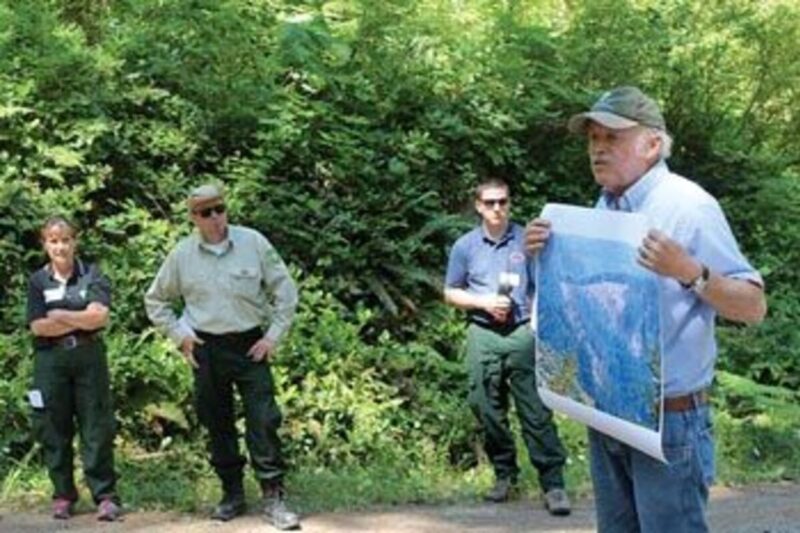Sean C. Morgan
The Bureau of Land Management is planning a newer type of timber sale that will leave about a third of the trees behind, while timber management agencies and private companies are trying to get a handle on crime and high fire risk at a forest area a little south of the county line.
Members of the Linn and East Lane forest protective associations spent the day touring the McGowan-Shotgun Creek area on July 10.
The area is a loop off of Marcola Road, featuring a BLM environmental education area; the McGowan Overlook, where Interstate 5 is a tiny ribbon visible on the floor of the Willamette Valley; a proposed timber sale and the Shotgun Creek Recreational Area.
One topic of the tour was fire danger at the popular McGowan Overlook.
The overlook is definitely a “party spot,” said Greg Wagenblast, Oregon Department of Forestry South Cascades forester.
The ODF has responded to a couple of fires, one that burned two acres up there already in addition to abandoned campfires, he said. A Weyerhaeuser chopper and the Sweet Home Unit responded to help fight that blaze. The helicopter transported water from a pond provided in an agreement between the Sweet Home Unit and a private landowner.
“This is one of our higher-risk areas,” Wagenblast said. It’s popular with people from Eugene.
Last year’s largest fire, 20 acres, on the South Cascades district was at Buck Mountain, near the overlook, in September after many firefighters had gone back to school.
“This is a known spot, and everybody knows how to get up here,” said Karen Swearingen of the ODF East Lane Unit. The area is known for a variety of illegal activity, especially at night.
“There was vehicles and traffic like you wouldn’t believe,” Swearingen said. People were shooting. “There was just a lot of different things going on while we were trying to put out the fire.”
The fire suppression cost was $125,000.
This year, firefighters located a burning flat screen TV. A fire on July 4 was tied to fireworks. The fire crew had given a fire prevention message to an individual there earlier in the day.
These are costs borne by the protective districts, whose members pay taxes for fire suppression, said Cary Hart of Giustina Land and Timber. At stake are 45- to 70-year investments on private land, along with BLM forests.
BLM Eugene District Field Manager Bill O’Sullivan said that public access must be balanced with the fire suppression goals. The area is open to public access, but regulations have been implemented to help prevent fires.
Safety is also an issue, due to illegal activities that occur in the area.
In 1992, because of escalation in shooting, the BLM prohited shooting within 50 feet of the road.
“We think it’s time we need to re-look at that,” O’Sullivan said.
County patrols have been increased, and they’ve had an impact on criminal activity, he said. It’s gone from 120 cases per year to about 60 cases a year over the past couple of years.
The illegal activity, from drug manufacturing to dumping a body, happens during the night, said Greg Koester, a BLM community relations specialist.
Weyerhaeuser owns close to 14,000 acres in the area, said Tally Patton of Weyerhaeuser.
People still show up and shoot in the area, she said, holding up a .50-caliber casing like those found in the area.
“I don’t like being up here,” Patton said. “What we need to see is respectable use of the lands. We want to see something happen. We’ll support it.”
The same goes for many of the area residents, whose comments to BLM indicated they would like to see more limitations.
The tour also included a visit to an 80-year-old regenerated forest that has been thinned.
It’s the kind of stand where no more thinning is needed. Much of BLM’s land in the Willamette Valley is low on stands that can be thinned, limiting harvest opportunities; but it’s also missing “early seral” habitat, a young, open and brushy type of forest.
Norm Johnson, a professor of Forest Ecosystems and Society at Oregon State University, is suggesting regen harvests, with two sales planned within the next year on Eugene BLM land, to create new early seral habitat – early sequence of the forest ecological community.
The Sweet Home Ranger District is discussing the similar creation of new early seral forest in the Cool Soda Planning Area.
Following the development of the Northwest Forest Plan, regen harvest had come to a halt by about 2000, Johnson said. Sales were tied up in litigation. He believes the BLM can show a benefit by leaving trees behind in a major harvest to create open early seral forests.
To do anything with the forests at this point will require regen harvesting, he said, and the creation of early seral will justify it, avoiding litigation.
“We claim it has immediate ecological benefits, economic and social benefits,” Johnson said. At the McGown area site, some 300 of 400 acres would be harvested if the sale is completed. And it’s something that would form in a wild forest.
“We’re really talking about mimicking wild forests here,” Johnson said, “but you also get timber production.”
The forests have perhaps 5 to 10 percent early seral habitat, he said, and the federal land managers have only about 20 percent of the land, called “matrix,” to work with.
Right now, “we’re trying to get an audience again with the public, to move beyond thinning,” Johnson said.
LFPA President Scott Melcher of Sweet Home stressed the importance of collaboration among the various interests prior to taking the concept to the public.
Melcher Logging has been involved in projects with similar goals on the east side of the Cascades, and the Forest Service Sweet Home Ranger District is working on similar collaborative efforts in its All-Lands collaboration, which includes projects to create early seral areas in the Cool Soda Project Area.





